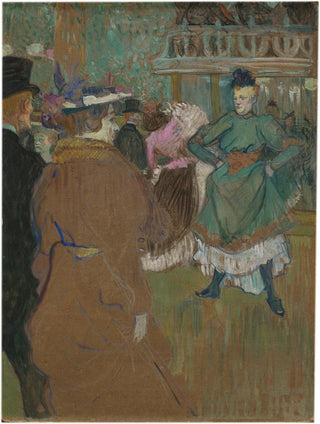Art print | Quadrille at the Moulin Rouge - Henri de Toulouse-Lautrec


View from behind

Frame (optional)
In the vibrant atmosphere of the Belle Époque, Henri de Toulouse-Lautrec masterfully captured the lively spirit of Paris through his iconic works. Among them, "Quadrille at the Moulin Rouge" stands out for its vivid and dynamic portrayal of the French capital's nocturnal pleasures. This art print, a true window into the fascinating universe of the cabaret, invites viewers to immerse themselves in the festive and colorful ambiance of the Moulin Rouge. Dance, music, and laughter intertwine, creating a scene where movement and emotion blend with rare intensity. Through this art print, one can almost feel the heartbeat of Paris, pulsating to the rhythm of quadrilles and waltzes.
Style and uniqueness of the piece
L Toulouse-Lautrec's style is immediately recognizable, combining a palette of vibrant colors with bold drawing techniques. In "Quadrille at the Moulin Rouge," the artist employs flowing lines and stylized forms to depict the characters, emphasizing their expressiveness. The figures, both elegant and caricatured, reflect a meticulous observation of society of his time. The composition is a visual ballet where each element seems to dance, reinforcing the idea of movement that prevails in this festive scene. The interplay of shadow and light, along with contrasts between warm and cool colors, creates an atmosphere that is both lively and melancholic, mirroring a Paris in full effervescence but also tinged with nostalgia.
The artist and his influence
Henri de Toulouse-Lautrec, often regarded as the visual chronicler of the Belle Époque, transcended the artistic conventions of his era. His work at the Moulin Rouge and other Parisian cabarets paved the way for a new way of viewing nightlife, far from the idealized representations that prevailed before. By focusing on the working classes and cabaret artists, he redefined the subjects worthy of painting, highlighting the beauty and complexity of everyday life. His influence endures today, inspiring many artists and movements seeking to capture the essence of modernity.

Matte finish

View from behind

Frame (optional)
In the vibrant atmosphere of the Belle Époque, Henri de Toulouse-Lautrec masterfully captured the lively spirit of Paris through his iconic works. Among them, "Quadrille at the Moulin Rouge" stands out for its vivid and dynamic portrayal of the French capital's nocturnal pleasures. This art print, a true window into the fascinating universe of the cabaret, invites viewers to immerse themselves in the festive and colorful ambiance of the Moulin Rouge. Dance, music, and laughter intertwine, creating a scene where movement and emotion blend with rare intensity. Through this art print, one can almost feel the heartbeat of Paris, pulsating to the rhythm of quadrilles and waltzes.
Style and uniqueness of the piece
L Toulouse-Lautrec's style is immediately recognizable, combining a palette of vibrant colors with bold drawing techniques. In "Quadrille at the Moulin Rouge," the artist employs flowing lines and stylized forms to depict the characters, emphasizing their expressiveness. The figures, both elegant and caricatured, reflect a meticulous observation of society of his time. The composition is a visual ballet where each element seems to dance, reinforcing the idea of movement that prevails in this festive scene. The interplay of shadow and light, along with contrasts between warm and cool colors, creates an atmosphere that is both lively and melancholic, mirroring a Paris in full effervescence but also tinged with nostalgia.
The artist and his influence
Henri de Toulouse-Lautrec, often regarded as the visual chronicler of the Belle Époque, transcended the artistic conventions of his era. His work at the Moulin Rouge and other Parisian cabarets paved the way for a new way of viewing nightlife, far from the idealized representations that prevailed before. By focusing on the working classes and cabaret artists, he redefined the subjects worthy of painting, highlighting the beauty and complexity of everyday life. His influence endures today, inspiring many artists and movements seeking to capture the essence of modernity.






